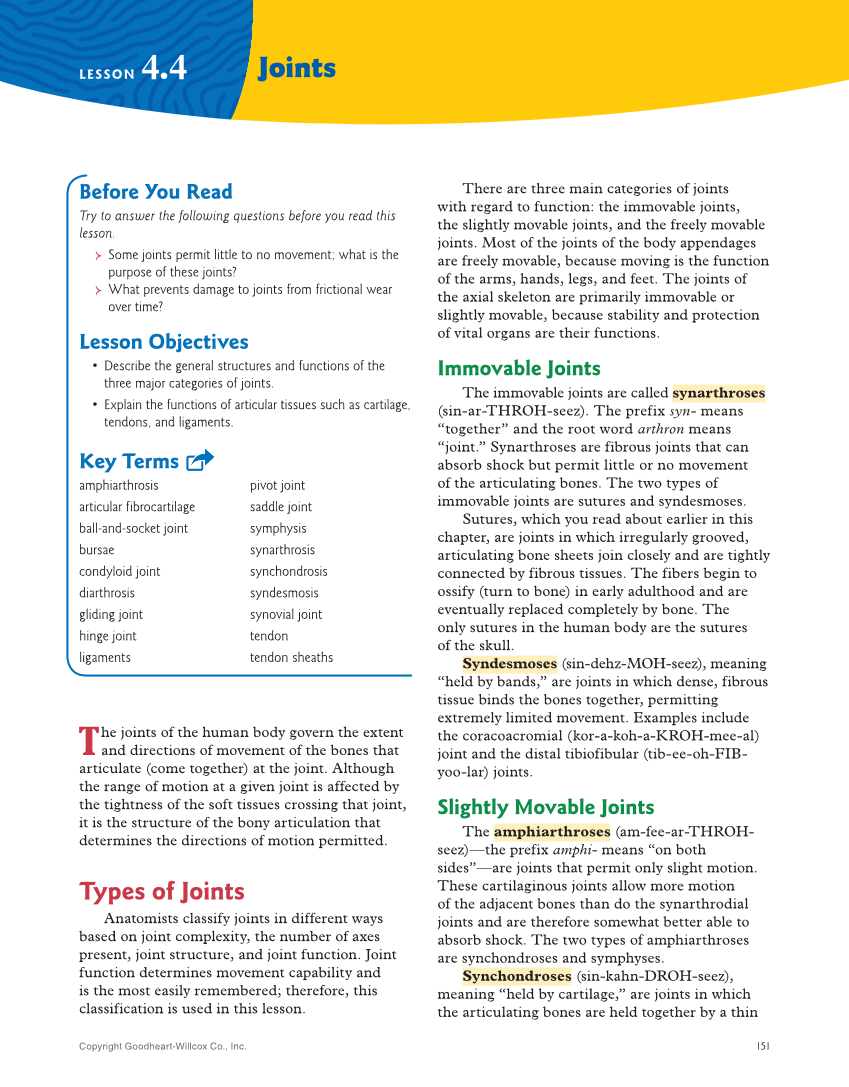151 There are three main categories of joints with regard to function: the immovable joints, the slightly movable joints, and the freely movable joints. Most of the joints of the body appendages are freely movable, because moving is the function of the arms, hands, legs, and feet. The joints of the axial skeleton are primarily immovable or slightly movable, because stability and protection of vital organs are their functions. Immovable Joints The immovable joints are called synarthroses (sin-ar-THROH-seez). The prefix syn- means “together” and the root word arthron means “joint.” Synarthroses are fibrous joints that can absorb shock but permit little or no movement of the articulating bones. The two types of immovable joints are sutures and syndesmoses. Sutures, which you read about earlier in this chapter, are joints in which irregularly grooved, articulating bone sheets join closely and are tightly connected by fibrous tissues. The fibers begin to ossify (turn to bone) in early adulthood and are eventually replaced completely by bone. The only sutures in the human body are the sutures of the skull. Syndesmoses (sin-dehz-MOH-seez), meaning “held by bands,” are joints in which dense, fibrous tissue binds the bones together, permitting extremely limited movement. Examples include the coracoacromial (kor-a-koh-a-KROH-mee-al) joint and the distal tibiofibular (tib-ee-oh-FIB- yoo-lar) joints. Slightly Movable Joints The amphiarthroses (am-fee-ar-THROH- seez)—the prefix amphi- means “on both sides”—are joints that permit only slight motion. These cartilaginous joints allow more motion of the adjacent bones than do the synarthrodial joints and are therefore somewhat better able to absorb shock. The two types of amphiarthroses are synchondroses and symphyses. Synchondroses (sin-kahn-DROH-seez), meaning “held by cartilage,” are joints in which the articulating bones are held together by a thin Before You Read Try to answer the following questions before you read this lesson. Some joints permit little to no movement what is the purpose of these joints? What prevents damage to joints from frictional wear over time? Lesson Objectives • Describe the general structures and functions of the three major categories of joints. • Explain the functions of articular tissues such as cartilage, tendons, and ligaments. Key Terms amphiarthrosis articular fibrocartilage ball-and-socket joint bursae condyloid joint diarthrosis gliding joint hinge joint ligaments pivot joint saddle joint symphysis synarthrosis synchondrosis syndesmosis synovial joint tendon tendon sheaths The joints of the human body govern the extent and directions of movement of the bones that articulate (come together) at the joint. Although the range of motion at a given joint is affected by the tightness of the soft tissues crossing that joint, it is the structure of the bony articulation that determines the directions of motion permitted. Types of Joints Anatomists classify joints in different ways based on joint complexity, the number of axes present, joint structure, and joint function. Joint function determines movement capability and is the most easily remembered therefore, this classification is used in this lesson. Joints LESSON 4.4 Copyright Goodheart-Willcox Co., Inc.
